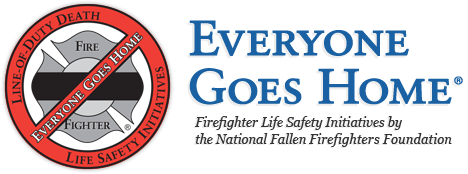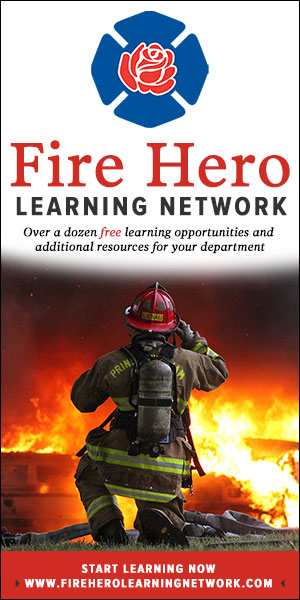While forming a committee to achieve a goal may not seem like an original idea, the Illinois Firefighter Life Safety Task Force is an exception. This unique group, representing all branches of the fire service, comes to the table with one common goal: to advocate for firefighter safety. The result is a successful approach to reaching a broad audience with important messages and training opportunities.
For their hard work in 2013, the National Fallen Firefighters Foundation awarded the Task Force with the prestigious Firefighter Life Safety Initiatives Program Seal of Excellence.
“We were very pleased to present the award to the Illinois Task Force,” said Victor Stagnaro, director of the Foundation’s Fire Service Programs. “Strong leadership, a willingness to collaborate and tirelessly promoting firefighter safety sets this group apart and exemplifies what the Seal of Excellence stands for.”
The Task Force began several years ago, when Chief Ralph Webster of the Woodstock Fire/Rescue District was a Director with the Illinois Fire Chiefs Association (IFCA). He received a request for nominees from the NFFF for Everyone Goes Home® Advocates, which help the Foundation educate fire service members about the 16 Firefighter Life Safety Initiatives. Since he had not yet been assigned an area of responsibility as an IFCA Director, and he felt very strongly about the importance of personal safety and accountability, Chief Webster decided to take on the role.
“The Chief is always the one telling others what to do. But the fact is, we all have to participate in our safety,” said Webster. “I expect accountability from everyone, from the top down. So I felt it was something I had to do.”
As Webster became more involved with the Advocates, he felt it was important to include all the fire service organizations throughout the state in this program, rather than just one person acting and speaking for many. As a model, he looked to the Illinois Fire Service Association, which includes appointees from different districts, municipal fire departments, chiefs and fire marshals to address various issues for the state. Webster contacted representatives from different perspectives of the fire service and found enthusiasm for the Task Force.
After reviewing the information from the Everyone Goes Home® program, the entire group agreed that they wanted – and needed – to promote the 16 Initiatives and deliver the Courage to Be Safe® training to the entire state. After working to spread the word about the Initiatives and CTBS, the Task Force chose to focus on seatbelt safety.
“A line-of-duty death is often viewed as admirable if it’s done saving someone. We often ignore that most LODDs happen in other ways,” said Webster. “Since roughly 22 percent of LODDs are from crashes and not using seat belts, the easiest thing I can do as a firefighter to be safe is use a seat belt all the time.”
Using the “Buckle Up! So Everyone Goes Home” campaign as a guide they also looked at the seat belt campaign from the National Highway Traffic Safety Administration to see how they reached the general public. Following those models, the Task Force produced the video “It’s More Than Just Seatbelts” to illustrate the consequences of not wearing a seat belt.
“The title (of the video) is intentional; it’s really not just about seatbelts. Everyone needs to use the same approach to safety and accountability whether you’re wearing your air packs, operating on an emergency scene, or living a heart-healthy lifestyle,” Webster said.
The video features members of the Stone Park, Illinois, Fire Department talking about the line-of-duty death of Jeffrey Bergstrom. On April 27, 2004, engines from Stone Park and another department were responding to a house fire when they collided. Bergstrom, who was not wearing his seatbelt, was ejected from the passenger seat and was killed. In the video, his friends and coworkers agree that a seat belt would have saved his life.
Ed and Meg DiMartino from East Greenbush, New York, also share their story. On the night of February 18, 2009, Ed was responding from his home to an incident. The roads were icy, and he crashed. Although he was not wearing a belt, DiMartino survived the crash; however, his memory, emotions, equilibrium, and speech were severely affected. Meg now describes him as a completely different person as a result of the crash and his decision not to wear his seatbelt.
The Task Force felt that both messages were very powerful. They also believed that sharing the DiMartino’s story would illustrate the toll injuries can also take on a family. When a firefighter decides not to wear a seatbelt – or fails to perform any action without appropriate safety equipment—the potential harm is not just to the firefighter. It impacts other crew members and their families. It’s more than just about seatbelts.
“We included Ed DiMartino in the video because we wanted people to see what can happen – not just death – that can impact an entire family, and how it drastically changes everyone’s life,” explained Webster. “I think the message in the video is clear, ‘You need to take your safety seriously. If not, these are the people you’ll let down.’”
The Task Force secured funding by reaching out to area businesses and organizations, including the Illinois Public Risk Fund, the Aileen S. Andrew Foundation and Motorola Solutions, and raised twice what they needed for production costs. This enabled the Task Force to distribute the video to all 1,200 departments in the state. They also made it available online and used social media to promote it. The Task Force used the remaining funds to train more than 3,000 firefighters in Courage to Be Safe®.
“They have a very progressive approach to reaching firefighters with essential training and information,” said Stagnaro. “They took the basic tool kit that we provided and tailored it to meet their needs. We hope other departments and organizations will do the same.”
To see the video or for information about the Task Force, go to eghillinois.org. For information about becoming an Advocate, Courage to Be Safe® training and other Everyone Goes Home® programs, go to www.everyonegoeshome.com.


